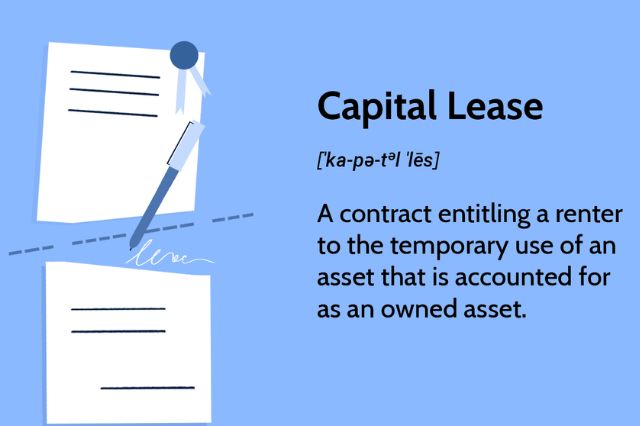Capital leases, also known as finance leases, are a prevalent and advantageous method for businesses to acquire long-term assets without making an outright purchase. These leasing arrangements allow companies to utilize essential assets such as machinery, equipment, and property for a specified period, while enjoying the benefits of ownership. This article will provide an in-depth understanding of capital leases, their unique features, and the numerous benefits they offer to businesses.
Defining Capital Leases
A capital lease is a long-term contractual agreement between a lessor (owner of the asset) and a lessee (the business that needs the asset). The lessor retains legal ownership of the asset, while the lessee obtains the right to use it for a fixed period, typically covering the majority of the asset’s useful life. The lessee assumes most of the risks and rewards of ownership, and the leased asset is recorded on the lessee’s balance sheet as if it were an owned asset.
Distinctive Features of Capital Leases
For a lease to be classified as a capital lease, it must meet at least one of the following criteria:
Ownership Transfer: The lease agreement includes a provision for the transfer of ownership to the lessee at the end of the lease term.
Bargain Purchase Option: The lessee can purchase the asset at a price significantly lower than its fair market value at the end of the lease term.
Lease Term: The lease term covers at least 75% of the asset’s estimated useful life.
Present Value: The present value of the minimum lease payments is at least 90% of the asset’s fair market value.
Benefits of Capital Leases for Businesses
There are a multitude of benefits when businesses use a capital lease, here are the most important:
Preservation of Cash Flow
Capital leases enable businesses to acquire necessary assets without bearing the burden of large upfront costs. Instead of paying the full purchase price, companies make periodic lease payments throughout the lease term. This approach allows them to maintain cash reserves, which can be allocated to other operational and investment needs. By preserving cash flow, businesses can remain financially stable and flexible, better positioning themselves to adapt to changes in the market and respond to new opportunities.
Tax Advantages
One of the most significant benefits of capital leases is the potential for tax savings. Under a capital lease, businesses can claim both depreciation expenses and interest expenses as tax deductions. Depreciation expenses are calculated based on the asset’s value and useful life, while interest expenses are derived from the lease payments’ financing portion. These deductions can lead to substantial tax savings, particularly for businesses that lease high-value, depreciable assets. By reducing their tax liability, companies can further optimize their financial performance and allocate resources to other areas of their business.
Improved Financial Ratios
Capital leases can have a positive impact on a company’s financial ratios, making it more attractive to potential investors and lenders. By opting for a capital lease instead of purchasing an asset outright, businesses can maintain a lower debt-to-equity ratio. A lower debt-to-equity ratio is generally perceived as an indicator of financial stability and lower risk, as it demonstrates a company’s ability to meet its financial obligations without relying heavily on borrowed funds. Additionally, capital leases can contribute to higher return on assets (ROA) and return on equity (ROE) ratios, further enhancing a company’s financial standing and attractiveness to investors.
Flexibility
Capital leases provide businesses with a considerable degree of flexibility when it comes to managing their assets. At the end of the lease term, companies have several options: they can choose to purchase the leased asset, return it to the lessor, or negotiate a new lease agreement. This flexibility enables businesses to adapt their asset management strategy according to their needs and financial situation. For example, if a company’s operational requirements change, it can decide not to renew the lease, thereby avoiding the costs associated with owning an asset that is no longer useful or relevant.
Access to Advanced Technology
In industries where technology evolves rapidly, capital leases offer a distinct advantage by allowing businesses to utilize cutting-edge equipment and machinery without committing to outright ownership. As a result, companies can stay competitive and adapt to changing market conditions more effectively. By periodically upgrading their leased assets, businesses can maintain operational efficiency and take advantage of technological advancements, ultimately driving innovation and growth.
Capital Lease Accounting Treatment
Capital lease accounting differs from that of operating leases due to the lessee’s assumption of risks and rewards associated with asset ownership. As a result, both the leased asset and the corresponding lease liability are recorded on the lessee’s balance sheet. The leased asset is typically amortized over the lease term or the asset’s useful life, depending on which is shorter. The lease liability is reduced by the principal portion of each lease payment, while the interest portion of each payment is expensed on the income statement. This approach provides a more accurate reflection of the lessee’s financial position and obligations related to the leased asset.
Capital Lease vs. Operating Lease
It is crucial to distinguish between capital leases and operating leases when evaluating leasing options. While capital leases are treated as a form of financing, operating leases are more akin to rental agreements. Under an operating lease, the lessee does not assume the risks and rewards of ownership and does not record the leased asset on its balance sheet. Lease payments are treated as operating expenses and are fully deductible for tax purposes. Operating leases can offer businesses greater flexibility and lower costs, especially for assets with a shorter useful life or lower residual value. However, businesses do not build equity in the leased asset and may face higher long-term costs compared to a capital lease.
Evaluating Capital Lease Prospects
Before entering into a capital lease, businesses should carefully evaluate the financial implications and long-term effects on their operations. This includes assessing the cost of financing the lease, the potential tax benefits, and the impact on financial ratios. Additionally, it is essential to consider the compatibility of the leased asset with the company’s long-term strategy and the potential consequences of obsolescence. Engaging with experienced financial advisors and performing thorough due diligence can help businesses determine if a capital lease is the most suitable financing option for their specific needs and goals.
Capital leases offer businesses a valuable alternative to purchasing long-term assets outright. By providing access to essential assets while preserving cash flow, offering tax advantages, improving financial ratios, and granting flexibility, capital leases can be an essential tool for businesses looking to optimize their operations and stay competitive in a dynamic marketplace.












